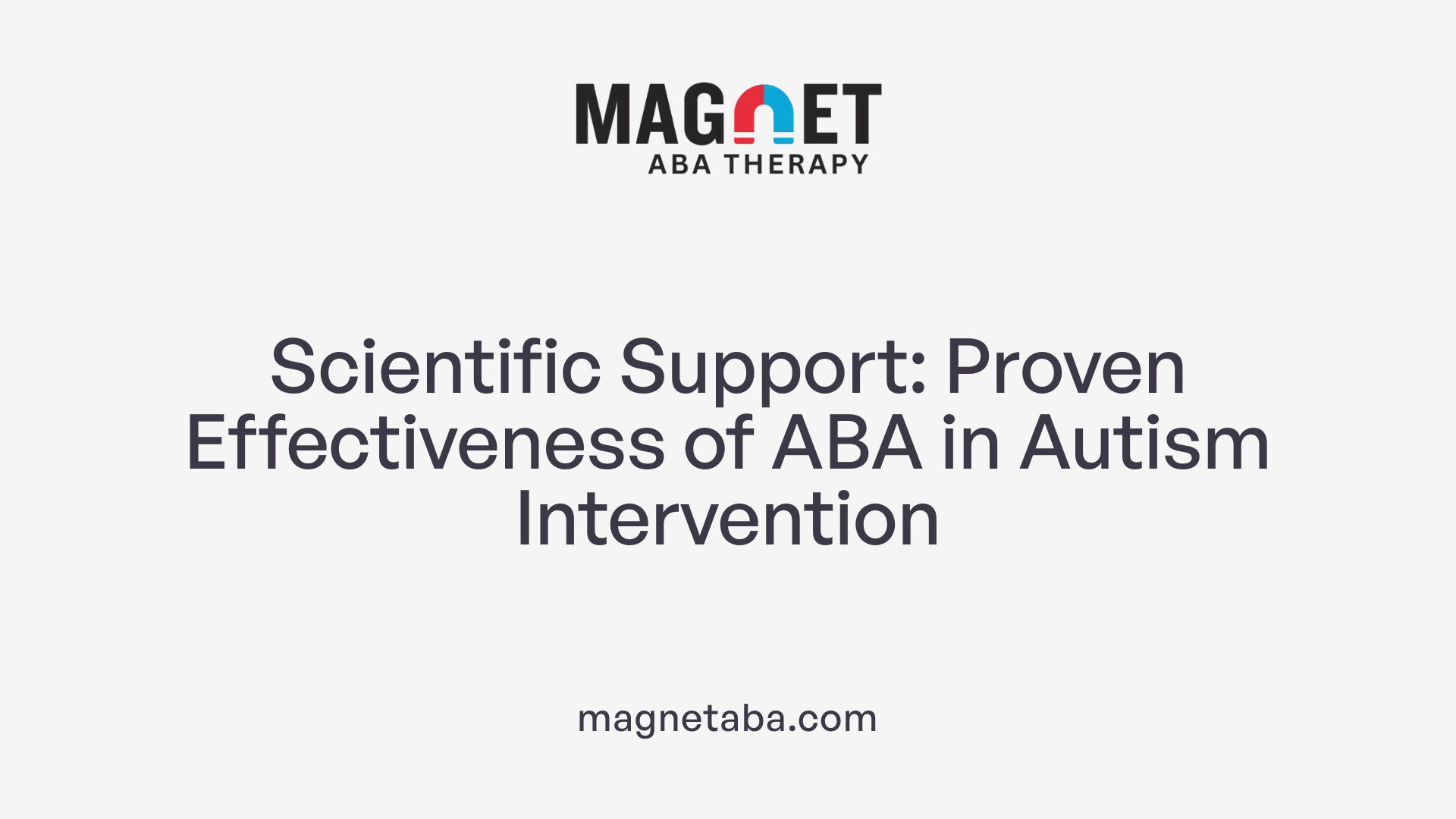Understanding ABA and Its Role in Autism Support
Applied Behavior Analysis (ABA) is a scientifically validated approach that has revolutionized intervention strategies for children with autism spectrum disorder (ASD). Recognized as an evidence-based treatment by prominent health authorities, ABA focuses on understanding the environmental factors that influence behavior and uses data-driven techniques to foster meaningful skill development and behavior change.
What is ABA Therapy and Its Core Principles

What is ABA therapy and how does it benefit children with autism?
Applied Behavior Analysis (ABA) is a scientifically supported therapy designed to help children with autism develop vital skills and reduce behaviors that can interfere with learning and social interaction.
ABA uses proven techniques such as positive reinforcement, prompting, and detailed behavior analysis to shape desired behaviors. This approach focuses on enriching areas like communication, social skills, attention, self-care, and academics.
One of the strengths of ABA is its individualized nature. Each child's therapy plan is tailored based on their unique strengths, interests, and developmental goals. This personalized approach is developed and overseen by trained professionals known as Board Certified Behavior Analysts (BCBAs).
Research consistently shows that long-term, intensive ABA programs—often involving 25 to 40 hours per week—can lead to significant progress. Children participating in early and sustained interventions often demonstrate improvements in language, social skills, and daily living activities.
The core of ABA relies on understanding how behaviors are influenced by the environment. Behavioral data guides decision-making, helping clinicians modify interventions to maximize positive outcomes.
How does the science behind ABA support its effectiveness?
ABA is rooted in behavioral and learning sciences, observing how environmental factors shape behavior.
It employs methods like the ABC model—where Antecedents (triggers), Behavior, and Consequences are analyzed to understand and change behaviors.
By systematically reinforcing useful behaviors and systematically reducing negative or non-productive actions, ABA creates meaningful behavioral change.
What are the guiding principles of ABA?
- Positive Reinforcement: Rewards are used to encourage desirable behaviors, making it more likely they will be repeated.
- ABC Model: Behavior is understood and influenced through analysis of antecedents, the behavior itself, and the consequences.
- Data-Driven Decisions: Continuous assessment guides adjustments in therapy, ensuring each child progresses at their own pace.
Who delivers ABA therapy?
ABA services are provided by trained professionals—primarily Board Certified Behavior Analysts (BCBAs)—who assess the child's needs and develop personalized treatment plans. Support is provided by therapists and registered behavior technicians (RBTs) who implement the interventions.
In summary, ABA is a well-established, scientifically validated approach that has transformed the lives of many children with autism. By focusing on environmental influences, reinforcing positive behaviors, and continually adapting strategies, ABA helps children learn essential life skills and participate more fully in society.
Goals and Outcomes of ABA Therapy

What goals does ABA therapy typically aim to achieve?
ABA therapy, or Applied Behavior Analysis, targets a range of developmental and behavioral goals customized to each individual. Primarily, it seeks to enhance communication skills—helping children understand and use language effectively, both receptively and expressively. This includes teaching children to imitate sounds, words, and phrases, and to respond appropriately during social interactions.
Another crucial focus of ABA is improving social skills. This involves teaching children to share, take turns, initiate conversations, and read social cues, which are essential for building meaningful relationships. Additionally, ABA emphasizes the development of daily living skills such as dressing, toileting, and sleeping, which foster independence.
Academic skills are also a core element, where children learn to wait, ask questions, and transition smoothly between activities—skills vital for classroom success. Besides skill acquisition, ABA aims to reduce harmful or disruptive behaviors like biting, kicking, yelling, or throwing objects, creating a safer and more positive environment.
The approach uses evidence-based strategies like positive reinforcement—rewards for desired behaviors—and understanding how antecedents and consequences influence actions. These techniques help establish and maintain new skills while diminishing problematic behaviors.
Goals are highly individualized. Therapists evaluate each person’s strengths and needs to set attainable, meaningful objectives. Overall, ABA works to build a foundation for independence, emotional regulation, and community participation.
By strengthening essential skills and reducing barriers, ABA aims to improve quality of life. Its structured, scientifically supported interventions help individuals reach their full potential, fostering greater autonomy and happiness in daily life.
Scientific Evidence Supporting ABA Effectiveness

What evidence supports the effectiveness of ABA therapy?
Scientific research provides strong backing for the benefits of ABA therapy. Numerous meta-analyses and carefully controlled studies have consistently shown that ABA can promote improvements in communication, social skills, and daily living behaviors. These studies often report small to moderate gains in expressive language and adaptive functioning, validating ABA as an effective treatment for children with autism.
Early intervention, especially when intensive, has demonstrated significant positive outcomes. Children who begin ABA therapy at a young age and receive enough hours of treatment tend to develop better social and language skills, increasing their chances of participating in mainstream classrooms and society.
Research also reveals a clear dose-response relationship: more therapy hours generally lead to better results. For example, children receiving more than 20 hours of ABA weekly show marked developmental advances, particularly if the intervention is sustained over time.
These findings are supported by a range of scientific methods, including randomized controlled trials and single-case experimental designs, which reinforce the reliability of ABA’s effectiveness. Recognized by the US Surgeon General and the American Psychological Association as an evidence-based treatment, ABA continues to be the gold standard in autism intervention, helping reduce problematic behaviors while fostering essential skills for independence.
Techniques and Strategies in ABA
What techniques are used in ABA therapy?
Applied Behavior Analysis (ABA) employs a range of proven methods to help individuals learn new skills and reduce problematic behaviors. At the core are reinforcement strategies, where positive reinforcements such as praise, rewards, or tokens encourage desired behaviors. Conversely, negative reinforcement can also be used to decrease undesirable behaviors.
Prompting and fading are crucial techniques where prompts (such as gestures, cues, or physical assistance) guide the learner towards the correct behavior. Over time, these prompts are gradually reduced or faded to foster independence.
Behavior chaining involves linking small steps (or behaviors) to form a complex task, such as dressing or cooking. Modeling demonstrates desired behaviors by showing the individual how to perform them, using visual or live demonstrations.
A fundamental framework in ABA is the ABC model, which analyzes the Antecedent (what happens before the behavior), the Behavior itself, and the Consequence (what follows the behavior). This helps identify triggers and reinforcement patterns.
Visual supports, including video modeling, social scripts, and visual aids, enhance understanding and imitation of behaviors. Other strategies like task analysis break complex skills into manageable steps, while behavior contracts establish clear expectations.
Extinction involves discontinuing reinforcement for problematic behaviors to decrease their occurrence. Redirection guides attention away from undesirable activities. Functional communication training teaches individuals to express their needs appropriately, which reduces behaviors stemming from communication difficulties.
All these techniques are supported by continuous data collection, ensuring that interventions are tailored and effective for each individual’s needs.
How are these techniques implemented?
Therapists and trained behavior analysts develop personalized programs, integrating these methods based on individual assessments. The goal is to promote meaningful learning, independence, and social engagement, helping individuals participate more fully in society.
Historical Development and Ethical Considerations of ABA
How has ABA therapy evolved from its early days to today?
Applied Behavior Analysis has a long history rooted in behaviorism, originally employing techniques that included aversive measures such as electric shocks to modify behavior in the 1960s. Over the years, this approach has transitioned toward more compassionate, naturalistic methods emphasizing positive reinforcement and skill development. The move away from punishment-based strategies has led to personalized, less intrusive interventions focused on teaching functional and independence skills.
Today’s ABA programs are flexible and designed around individual needs, incorporating play-based techniques and environmental adaptations. This evolution has made ABA more acceptable and effective, leading to better long-term outcomes for children with autism.
How have ethical standards in ABA changed over time?
Initially, ABA faced criticism due to the aggressive nature of some early interventions. As understanding improved, ethical standards evolved to prioritize client well-being, autonomy, and dignity. Regulatory bodies, like the Behavior Analyst Certification Board, now promote guidelines that enforce transparency, informed consent, and the use of least intrusive methods.
Emphasizing the importance of social validity ensures that interventions align with the values and preferences of those receiving therapy. Ongoing education encourages practitioners to stay current with ethical practices, fostering trust and positive relationships with clients and families.
Why is client autonomy and social validity important?
Respecting client autonomy involves actively involving individuals and their families in treatment planning. This ensures that therapy goals are meaningful and relevant, fostering motivation and engagement. Social validity refers to the acceptability and appropriateness of procedures and outcomes, crucial for ensuring that behavioral interventions enhance quality of life.
By focusing on these aspects, ABA therapy supports not just behavioral change but also personal growth and societal participation, aligning therapeutic practices with ethical principles.
What are some criticisms and controversies surrounding ABA?
Despite its proven effectiveness, ABA has faced criticism from neurodiversity advocates and some community members. Concerns include the perceived rigidity of early ABA methods, which could potentially suppress natural autistic behaviors and expressions.
Critics argue that some practices may impact an individual’s sense of identity, potentially fostering feelings of compliance rather than genuine acceptance of individual differences. There are also debates about the long-term impacts and the importance of incorporating autistic perspectives into treatment design.
Addressing these criticisms involves ongoing dialogue, transparency, and adapting practices to respect the autonomy and cultural values of individuals with autism. Continued research aims to refine ABA to be more inclusive, ethical, and supportive.
| Aspect | Description | Example |
|---|---|---|
| Historical Shift | From aversive to positive, naturalistic approaches | Use of punishment vs. reinforcement strategies |
| Ethical Standards | Focus on dignity, autonomy, and informed consent | Guidelines by ABA professional bodies |
| Criticisms | Concerns over rigidity and identity impact | Accusations of suppressing natural behaviors |
| Moving Forward | Incorporate neurodiversity and client-centered values | Inclusive practice and community input |
Controversies and Ethical Debates in ABA
Is ABA therapy harmful or controversial?
Applied Behavior Analysis (ABA) is recognized as an effective and scientifically supported intervention for children with autism, endorsed by reputable organizations like the U.S. Surgeon General and the American Psychological Association. Its primary goal is to help children learn essential skills and reduce problematic behaviors through techniques grounded in learning principles.
However, ABA has a complex history. Early practices sometimes involved aversive methods, such as electric shocks, which are now widely condemned and no longer used. Modern ABA programs prioritize positive reinforcement, play-based strategies, and humane interventions, aiming to support children ethically.
Despite its proven effectiveness, ABA remains a topic of debate, especially among autistic self-advocates. Critics highlight concerns about the intensity and repetitive nature of some therapies, which may lead to emotional distress or masking—where children hide their true behaviors and identity to conform to societal expectations.
Some argue that a strict focus on conformity can diminish neurodiversity—the acceptance of autism as a natural variation of human experience. These concerns emphasize the importance of ethical standards, individualized treatment plans, and respecting the rights and preferences of autistic individuals.
Ongoing developments aim to address past criticisms by promoting more respectful, flexible, and supportive approaches. Choosing providers who adhere to ethical guidelines and prioritize the well-being and autonomy of the individual is essential to minimize potential harms.
In summary, while ABA offers significant benefits when implemented ethically, it is vital to remain aware of its controversies. Respectful and personalized practices help ensure that therapy supports rather than harms, aligning intervention goals with the dignity and diversity of those it aims to serve.
For more insights into these discussions, you can search for "Controversies in ABA and neurodiversity" to explore ongoing debates and perspectives within the community.
Training and Becoming an ABA Therapist
How can I become an ABA therapist?
Embarking on a career as an ABA therapist involves a series of educational and practical steps. Initially, aspiring professionals should earn a bachelor's degree in a relevant field such as psychology, education, or sociology. This foundational step prepares individuals with essential knowledge of human behavior and development.
To progress further, especially toward becoming a Board Certified Behavior Analyst (BCBA), a master's degree in applied behavior analysis, psychology, or a related discipline is required. During this educational phase, students complete specific coursework in behavior analysis and related topics.
A crucial part of training involves gaining supervised experience. This typically amounts to around 1,500 to 2,000 hours, where students work under the guidance of a qualified BCBA. Practical experience helps solidify theoretical knowledge and develop real-world skills in implementing ABA techniques.
After completing the required coursework and supervised hours, candidates must pass the BCBA certification exam. This exam assesses their understanding of ABA principles, ethical considerations, and practical application.
In addition to certification, many states require ABA therapists to obtain licensure to practice legally. Continuing education is necessary not only for maintaining certification but also for staying updated with evolving best practices and advancements in the field.
Overall, becoming an ABA therapist requires a commitment to education, supervised practical experience, certification, and ongoing professional development. These steps ensure professionals are prepared to deliver effective, evidence-based ABA therapy to children and individuals with autism.
Fostering a Brighter Future with ABA
ABA remains a vital and scientifically supported approach to improving the lives of children with autism. By focusing on skill-building, behavior reduction, and personalized interventions, ABA helps unlock each child's potential for independence, social participation, and a fulfilling life. As the field continues to evolve, emphasizing ethical practices and individual rights ensures that ABA therapy remains effective and respectful of neurodiversity. Support from trained professionals, ongoing research, and family involvement are crucial for maximizing its benefits and shaping a more inclusive society where children with autism can thrive.












